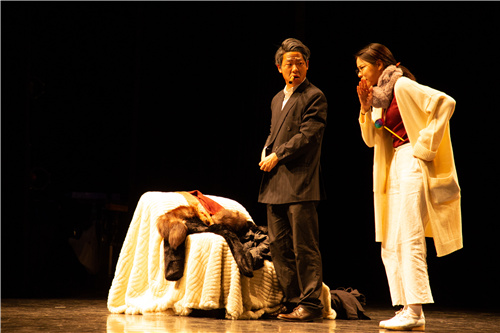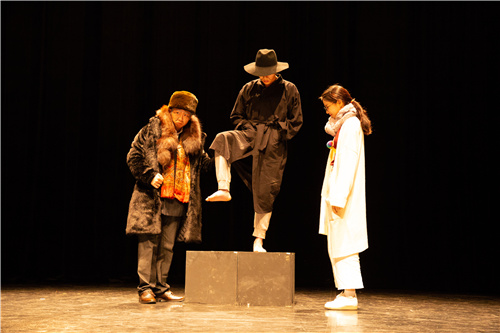
Director: Geon Pyo Kim
Playwright: Samuel Beckett
Institution: Chungwoon University
Venue: Chung - Ang University, Korea
Time: 13:30, May 19, 2018
Event: 5th Asian Theatre Schools Festival

Director’s Notes
My directing objective is to fill the space of the stage with theatrical elements such as music, lighting, action, makeup, actor, etc., to complete the theme of the play and to allow the audience to appreciate it.
What is important for me in participating in this festival, where various countries and languages coexist, is to express the things in the text in an audiovisual manner, not as a language, and ultimately to those who do not know Korean to understand the drama without any subtitles. The reason for choosing these two short plays is because the composition of the lines are broken. The physical expression, gestures and variation of speech of the actors go beyond the text to be heightened by music and light.
The props for 'Catastrophe' is one chair and one cube in an empty stage, and clothes can express jars in 'Play.' Especially, in the work of 'Play,' where all actors are in the jar, the gestures of the actors cannot be seen and only the face will be seen. Then the audience can concentrate on the actor by using minimal props rather than adding other elements.
To sum up, it will make the theme of the play more detailed and dense by emphasizing specific parts of the actors, while excluding others.

Synopsis
Running Time: 60 minutes
Piece 1: Ohio Impromptu
Late at night, both in same attires, a 'reader' tells a 'listener' the story of the woman he loves...
Piece 2: Play
The curtain rises on three identical grey funeral "urns", about three feet tall by preference, arranged in a row facing the audience. They contain three stock characters. In the middle urn is a man (M). To his right is his wife (W1) or long-time partner. The third urn holds his mistress (W2).
At the beginning and end of the play, a spotlight picks out all three faces, and all three characters recite their own lines, in what Beckett terms a "chorus"; the effect is unintelligible. The main part of this play is made up of short, occasionally fragmented sentences spoken in a "rapid tempo throughout".
One character speaks at a time and only when a strong spotlight shines on his or her face. While one is talking the other two are silent and in darkness. They neither acknowledge the existence of the others around them nor appear aware of anything outside their own being and past.
In an almost fuga style the three obsess over the affair. Each presents his or her own version of the truth told in the past tense and each from his or her respective points of view..
Towards the end of the script, there is the concise instruction: "Repeat play." The purpose of this is to suggest a gradual winding down of the action for he writes of "the impression of falling off which this would give, with the suggestion of a conceivable dark and silence in the end, or of an indefinite approximating towards it."At the end of this second repeat, the play appears as if it is about to start again for a third time, but does not get more than a few seconds into it before it suddenly stops.

Piece 3: Catastrophe
An autocratic Director and his female Assistant put the "final touches to the last scene' of some kind of dramatic presentation," which consists entirely of a man (The Protagonist) standing still onstage.
The Assistant has arranged the man as she sees fit, atop a "black block 18" high", draped in a "black dressing gown [down] to [his] ankles" and - peculiarly - sporting a "black wide-brimmed hat." The bulk of the drama consists of the Director wrestling control from her, trying to mould the man on stage to suit his personal vision.
The Director is an irritable and impatient man, his annoyance likely exacerbated by the fact that he has another appointment, "a caucus", to attend and his time there is limited. He expresses concern with the overall appearance and demands that the coat and hat be removed leaving the man "shivering" in his "old grey pyjamas." He has the man's fists unclenched and then joined, the only suggestion of his Assistant's that he pays any heed to; once arranged at breast-height he is satisfied. The Director dismisses his Assistant's proposal to have the man gagged or to "show his face ... just for an instant." He also has her make notes to whiten all of the exposed flesh.
In a moment of respite, when the Director leaves the stage, his Assistant collapses into his chair then springs out and wipes it vigorously, as if to avoid contamination, before reseating herself. This helps the audience appreciate better her relationship to each of the parties. She is, after all, the one who dressed the Protagonist warmly and who - twice - highlights the fact that he is shivering. In some ways she is just "another victim rather than a collaborator."
Finally they rehearse lighting with the theatre technician (the never-seen "Luke"). The play-within-a-play lasts only a few seconds: from darkness, to light falling on the man’s head and then darkness again. Finally the Director exclaims: "There's our catastrophe! In the bag" and asks for one last run through before he has to leave.He imagines the rising of the expectant applause on the opening day.
However, in an act of defiance, the man looks up into the audience (after having been looking down the entire time); the "applause falters and dies." A Pyrrhic victory perhaps. However "the figure's unexpected movement seems to happen not in the director's imagined time space but in the time space of [actual] performance. The moment is unsettling ... We do not know why the figure has reacted like this; we do not know when the reaction happens; we do not know where the reaction takes place."

